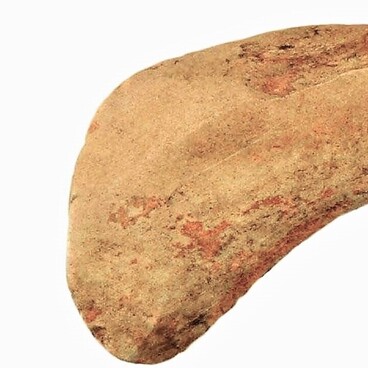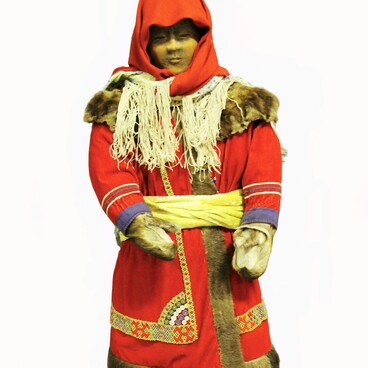The ethnographic collection of the museum complex houses traditional women’s clothing of the Yugan Khanty. Unlike men’s clothing, it does not disappear from everyday life so quickly, although its details change over time.
During the day, Khanty women wore a robe over their undershirts — sak. “Sak” is a common name for unfastened clothes of the Ob-Ugrians, made of different materials. The cut of the women’s sak did not differ from the men’s, but it was always below the knees. The right side of the unfastened clothes was wrapped over the left side and attached to it with the help of ties made of fabric, rovduga (suede), or leather.
The sak was usually plain, dark red, dark blue, or dark green fabric was mainly used. The Khanty had superstitions connected with the color of their clothes. For example, it was impossible to go into the forest in a red robe: it was believed that a snake or a bear could attack. No black-colored clothes were worn during the feast.
The Khanty used stripes of contrasting fabric and beaded ornamented overlays to decorate traditional outfits. Such patterns served not only as a decoration: by the ornament on shoes and clothes, it was possible to determine to which family a woman belongs to.
The narrowest stripes were sewn on the ends of the sleeves, the widest one — on the hem. In some cases, for example, during the funeral, beaded jewelry was removed. The researchers suggest that the Yugans could initially wear plain clothes. It was not possible to establish the time period when the tradition to sew stripes of contrasting fabric on women’s unfastened clothes started. Until now, this remains a subject of discussion among researchers.
The summer women’s sak from the exhibition “Ugra Heritage” was made in 1993. It was sewn by Lydia Kayukova from the Kayukovs settlement, located in the Nefteyugansk District. The material for the sak was a dark green broadcloth. The craftswoman’s robe is finished with red and blue cloth stripes. The right side is fastened with two pairs of ties. Beads of orange, red, blue, and green colors were used to create the decorations. The Khanty women sew and wear saks even today, they preserve the traditions of making national clothes.
During the day, Khanty women wore a robe over their undershirts — sak. “Sak” is a common name for unfastened clothes of the Ob-Ugrians, made of different materials. The cut of the women’s sak did not differ from the men’s, but it was always below the knees. The right side of the unfastened clothes was wrapped over the left side and attached to it with the help of ties made of fabric, rovduga (suede), or leather.
The sak was usually plain, dark red, dark blue, or dark green fabric was mainly used. The Khanty had superstitions connected with the color of their clothes. For example, it was impossible to go into the forest in a red robe: it was believed that a snake or a bear could attack. No black-colored clothes were worn during the feast.
The Khanty used stripes of contrasting fabric and beaded ornamented overlays to decorate traditional outfits. Such patterns served not only as a decoration: by the ornament on shoes and clothes, it was possible to determine to which family a woman belongs to.
The narrowest stripes were sewn on the ends of the sleeves, the widest one — on the hem. In some cases, for example, during the funeral, beaded jewelry was removed. The researchers suggest that the Yugans could initially wear plain clothes. It was not possible to establish the time period when the tradition to sew stripes of contrasting fabric on women’s unfastened clothes started. Until now, this remains a subject of discussion among researchers.
The summer women’s sak from the exhibition “Ugra Heritage” was made in 1993. It was sewn by Lydia Kayukova from the Kayukovs settlement, located in the Nefteyugansk District. The material for the sak was a dark green broadcloth. The craftswoman’s robe is finished with red and blue cloth stripes. The right side is fastened with two pairs of ties. Beads of orange, red, blue, and green colors were used to create the decorations. The Khanty women sew and wear saks even today, they preserve the traditions of making national clothes.



